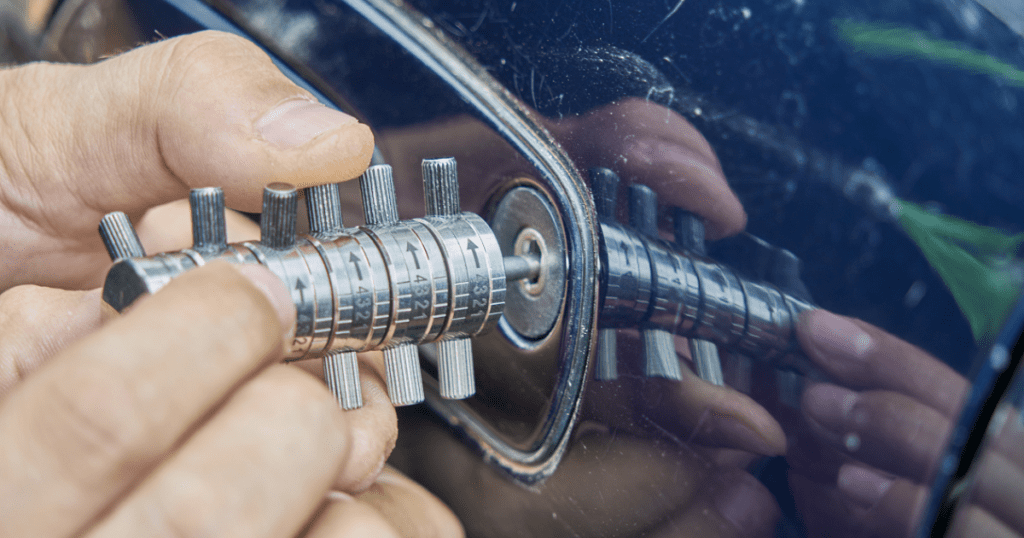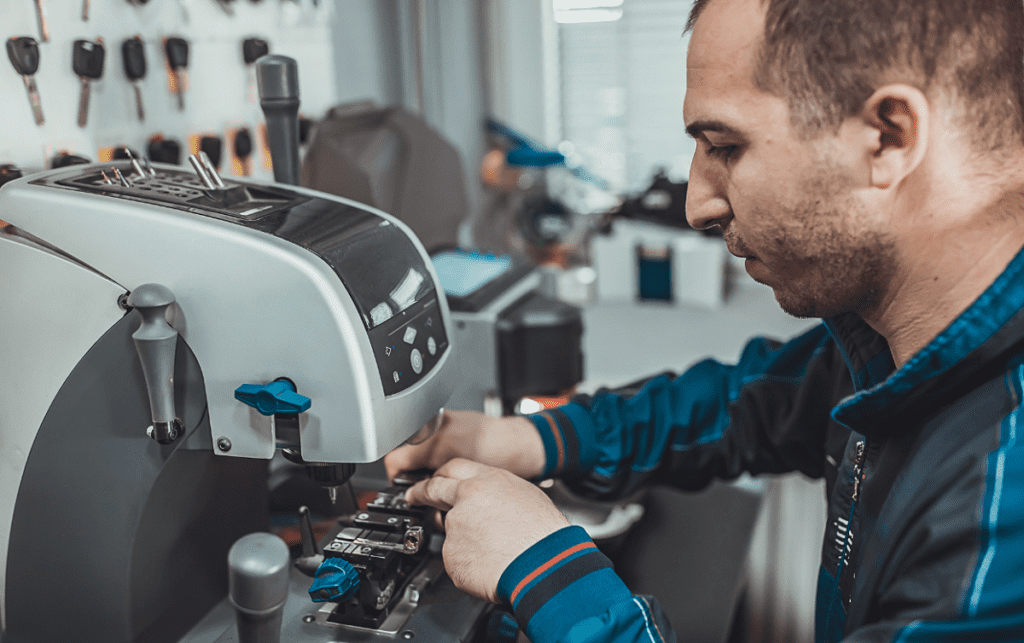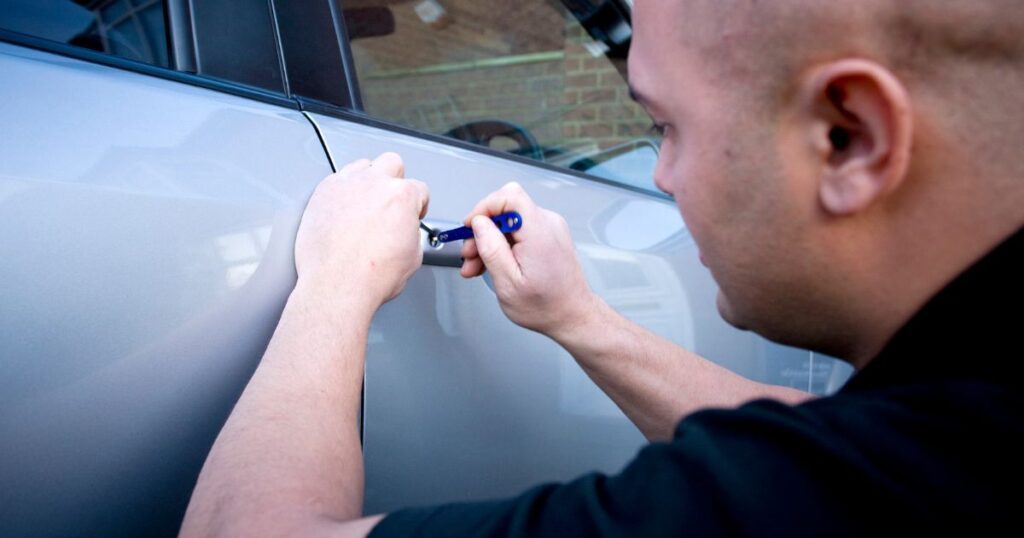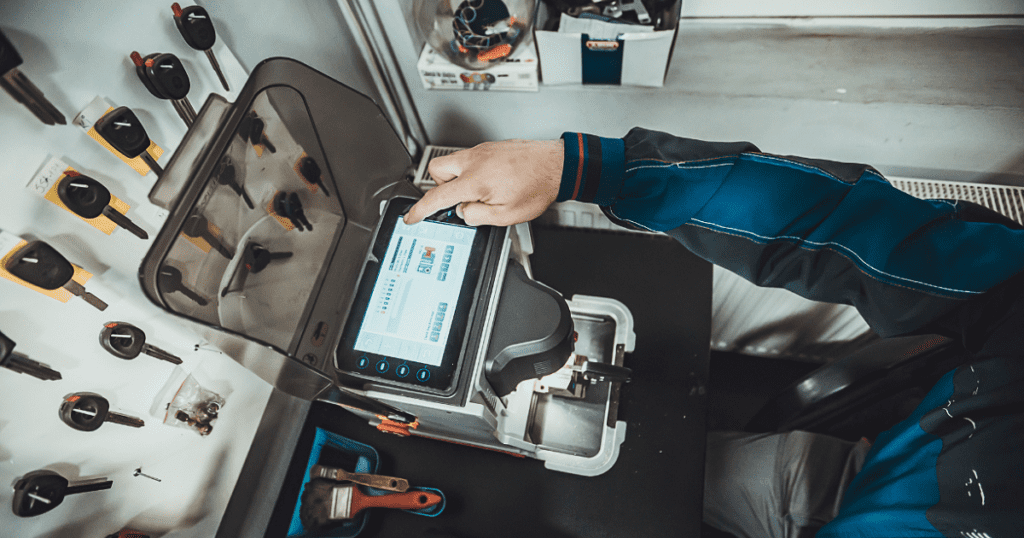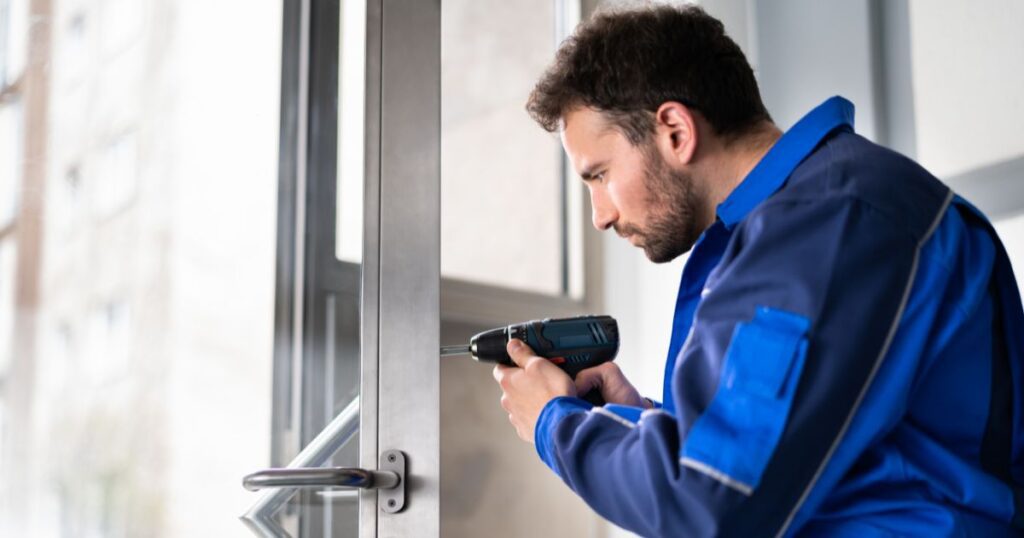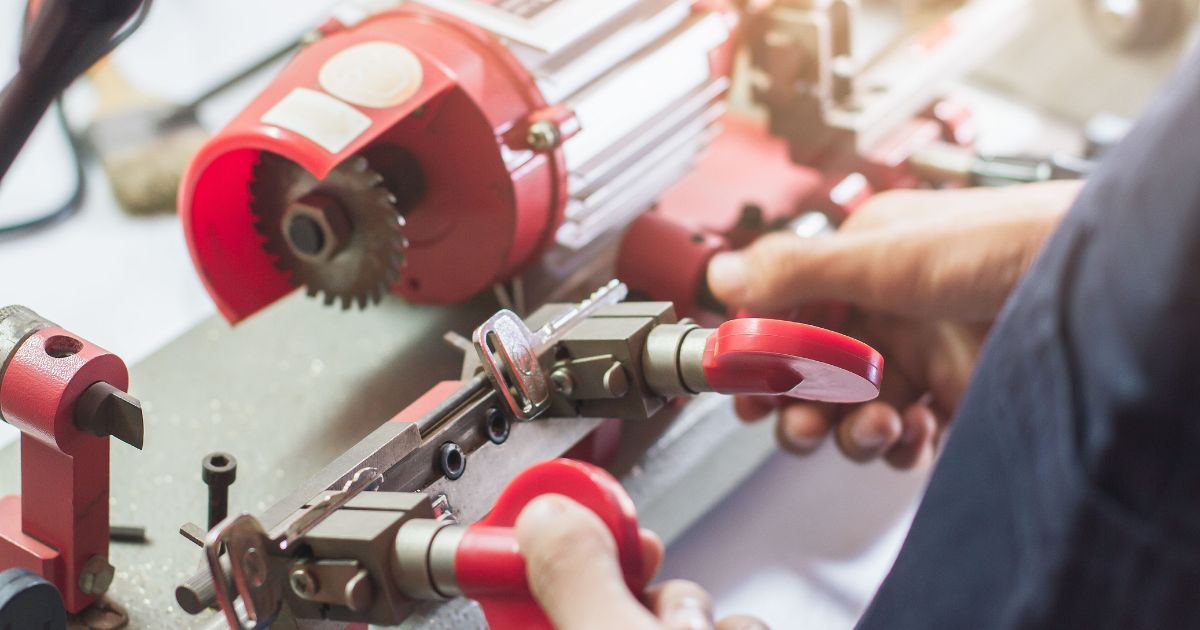
Spare Keys Are Essential
We’ve all experienced that sinking feeling when we realize we’ve lost our keys. Whether it’s locking ourselves out of our house or car, misplacing them at work, or simply forgetting where we put them, losing our keys can be a stressful and frustrating experience.
That’s where locksmiths come in – they’re the experts who can create duplicate door keys from the original, ensuring that we always have a spare key on hand. For those who aren’t familiar with the term, a locksmith is someone who specializes in creating and repairing locks.
They’re trained to work with all types of locks, from simple padlocks to high-tech electronic systems, and they’re skilled at duplicating keys. In short, if you need a new key for your house or car, a locksmith is the person you want to see.
Having spare keys is essential for anyone who wants to avoid being locked out of their home or vehicle. It’s also important for security reasons – if you ever lose your keys or they get stolen, having spare ones means that you can quickly replace them and prevent unauthorized access to your property. So what does the locksmith need from my door key to make a door key?
The Key to Making a Key
Creating duplicate door keys might seem like a simple process at first glance – after all, it’s just copying one key onto another. But in reality, there are many factors that go into making an accurate duplicate.
Locksmiths use specialized tools and equipment to create duplicates of existing keys. These tools allow them to make precise cuts on the new key blade so that it matches the original as closely as possible.
Additionally, locksmiths must take great care when handling the original key – any damage or wear on this key will impact how well the duplicate works. There are also security considerations when it comes to key reproduction.
In some cases, duplicating a key could pose a security risk if the original key falls into the wrong hands. For this reason, some locksmiths may require additional information or documentation before they’ll create a duplicate.
Inspecting Your Original Key
Before making a duplicate door key, your locksmith will need to inspect the original key carefully. They’ll look for signs of wear or damage on the blade, bow, and shoulder of the key. Additionally, they may take measurements of these components to ensure that the duplicate is created with precise dimensions.
Locksmiths also need to know what type of lock the original key works with and any other relevant information about the lock system. This information helps them create a duplicate that will work seamlessly with your existing lock.
Creating Your New Key
Once your locksmith has inspected your original key and gathered all necessary information about your lock system, they’ll begin creating your new duplicate door key. Using specialized tools and equipment, they’ll make precise cuts on the new key blade so that it matches the original as closely as possible.
It’s important to note that there are limitations when it comes to duplicating keys – not every type of key can be duplicated using standard techniques. However, the most common types of door keys can be duplicated accurately by an experienced locksmith.
Testing Your New Key
Once your new duplicate door key has been created, it will need to be tested for accuracy before it can be used on your locks. Your locksmith will insert the new key into each lock that it’s intended for and ensure that it turns smoothly and unlocks without any issues. It’s important to have your new duplicate tested thoroughly before you rely on it as a spare – this helps prevent any potential problems down the line and ensures that you always have a working backup in case you ever lose or misplace your original key.
The Key to Making a Key
Unlocking the Secrets of Duplicating Keys
When it comes to duplicating keys, there’s a lot more to it than just making a copy. A locksmith needs to have the proper tools and equipment, as well as an understanding of the key’s anatomy and profile. So, what does the locksmith need from my door key to make a door key?
Let’s dive into the process of key duplication. First things first: before any duplication can take place, your locksmith will examine your original key.
They’ll check for any signs of wear or damage, which could affect the accuracy of your new duplicate. Additionally, they’ll measure the key’s length and width, as well as examine its teeth pattern.
Once they have this information, it’s time for the real work to begin. The locksmith will select a blank key that matches your original in terms of size and shape.
They’ll then use their tools to cut grooves into this blank that match those on your original. There are different methods for doing this – some involve manually cutting each groove with a machine called a duplicator; others use computerized machines that can create duplicates with greater precision.
Regardless of which method is used, this step requires skill and precision on behalf of the locksmith. As they work on cutting grooves into your new key, they’ll also need to test it periodically in your lock to ensure that everything is fitting correctly.
This helps ensure that there won’t be any issues when you try to use your new duplicate. So what kind of tools do locksmiths typically use during this process?
One common tool is known as a “key cutter” – it looks similar to a pencil sharpener but is designed specifically for shaping keys. Other important tools include calipers (used for measuring), files (used for smoothing rough edges), and vises (used for holding the keys steady during cutting).
Overall, duplicating a key is a complex process that requires skill, knowledge, and precision. So the next time you need to make a new key, be sure to entrust the job to a skilled locksmith who can ensure that your new duplicate works correctly and fits your lock like a glove.
The Anatomy of a Door Key: Understanding the Parts of the Key
As a homeowner, it is essential to know the various parts of your door key. A typical door key consists of three parts: the blade, bow, and shoulder.
Each part plays an important role in creating an accurate duplicate. The blade is the flat, metal part that inserts into the lock.
It has ridges or cuts known as valleys and peaks that match up with those inside your lock cylinder. These valleys and peaks are unique to each lock; hence it is impossible to make a new key without having access to the original.
It’s important to understand that these valleys and peaks differ based on whether you have a pin-tumbler or wafer-tumbler lock. The bow is the top portion of your key.
It serves as an extension for turning, inserting, and removing your key from its lock cylinder effortlessly. The shape and size of the bow differ from one manufacturer or type of lock to another.
The shoulder separates between the blade and the bow. Its thickness varies depending on whether you have a single-cylinder deadbolt or double-cylinder deadbolt installed in your home.
The Role Each Part Plays in Creating an Accurate Duplicate
Locksmiths use various tools such as code machines, computer software programs, duplicating machines, electronic scanners, and hand tools like pliers cutters, just to mention but a few, when replicating keys accurately. The tools help in shaping each part accurately according to manufacturer specifications for better performance. When replicating your door key, locksmiths pay attention to every detail on each part.
For instance:
- They check for any wear-and-tear signs on both sides of each valley.
- They ensure that they cut at precise depths when cutting keys so that they match with those on the original.
- They cut the bow according to manufacturer specifications to ensure that it fits correctly with your lock cylinder.
- The shoulder helps locksmiths determine which key blank is compatible with your lock, making it impossible for others to make duplicates without authorization.
It’s critical that you understand the importance of all three parts when making a new key. Each one can affect how well your new key works and even small variations in any part of the key can result in improper functioning.
Understanding the anatomy of your door key is critical when it comes to having a duplicate made. Providing a locksmith with all relevant details, such as manufacturer specifications, wear-and-tear signs on both sides of each valley on your blade, precise depths at which cuts are made on keys, and measurements for the bow and shoulder, will guarantee an accurate replica.
What Your Locksmith Needs to Know
Providing Essential Information for Accurate Key Duplication
When it comes to duplicating your door key, providing your locksmith with the right information is key. Literally. While it may seem like a simple task to make a copy of your key, there are several factors that can affect the accuracy of the duplicate.
That’s why it’s essential to provide your locksmith with all the necessary details about your lock and existing key. Door key profiling for accurate duplication involves taking into account various components of the lock and key when creating a new copy.
Locksmiths need to know everything from the brand and model of your lock to its age and condition. Additionally, they will look at the shape, size, and material of your original key before making a duplicate.
Locksmith specifications for duplicating door keys are important because they determine which type of technology and tools will be necessary for duplication. Different types of keys require different cutting parameters, quality control standards, and measurement specifications for accurate replication.
The Importance of Brand and Model Information
One critical factor in ensuring that your new key works perfectly is knowing exactly what kind of lock you have installed on your door. Be sure to provide information about its brand name, model number, and any other relevant data, such as whether it is a deadbolt or knob set lock.
By providing this information up front, you’ll help ensure that the locksmith has all the necessary materials and instructions required for accurate reproduction. This process helps reduce errors in duplication procedures that can result in keys not working correctly or at all.
Quality Control Standards for Locksmith Key Duplication
Your locksmith takes quality control seriously when duplicating keys. They’ll check each component thoroughly during each step in creating an accurate duplicate by comparing each cut or angle with those found on the original door key. The old expression “measure twice, cut once” applies here.
The locksmith will take extreme care in using high-quality tools and equipment to ensure that your new key is a perfect replica of the original. Required data from the original key for reproduction is carefully analyzed to make sure that each cut or angle is precise.
Best Practices for Providing a Door Key to a Locksmith
To ensure that your new door key is an exact replica of the original, it’s important to provide as much information as possible about your existing keys and locks. This includes not only the brand and model information but also any security considerations, such as master keys or codes.
Make sure to bring in all existing keys you have for your lock system when having a duplicate made. Locksmiths may require additional information beyond what you provide, so be prepared to answer any questions they may have about your keys or locks.
Security Considerations During Door Key Reproduction
When providing information for key duplication to a locksmith, it’s important not to overlook security considerations related to your lock system. This includes providing any necessary coding or programming requirements that may be necessary for duplication.
Additionally, some door locks are designed with specific anti-tampering features that can prevent unauthorized access by criminals trying to pick the lock. To make sure these features continue working correctly after duplicating keys, verify with your manufacturer if you don´t risk losing them by duplicating them.
By taking these steps before having duplicates made, you can help ensure that your new keys won’t compromise the security of your home or business. Trusting an experienced locksmith who follows best practices when making duplicates is always recommended
Inspecting Your Original Key
Ensuring Accuracy and Precision in Door Key Replication
Before a locksmith can create a duplicate key, they need to inspect the original key. This step is crucial in ensuring that the new key will work perfectly with your lock. At first glance, keys might look identical, but upon closer inspection, there could be tiny differences that could render the new key useless.
This is why your locksmith will take their time to thoroughly examine your original key before proceeding with the door key replication process. During this inspection stage, your locksmith will check for signs of wear and damage on your original key.
They do this by using specialized tools that allow them to magnify every part of the blade and bow of the key. Any damage or wear on these parts could affect how well the new key fits into your lock.
Additionally, if there are any irregularities or deformations on the blade or bow of your original key, this could also impact the accuracy of door key duplication. The slightest imperfection could result in a poorly cut duplicate which may not work at all.
Therefore, it’s essential that you provide your locksmith with an original door key that’s in good condition for duplication purposes. If you’re unsure about whether or not it has been damaged or worn down over time, it’s best to let a professional inspect it first before proceeding with creating a duplicate.
Meticulous inspection is required before replicating a door key accurately. It should be emphasized how important it is for owners to maintain their keys in good condition and have them inspected from time to time by professionals like locksmiths before making duplicates.
Finding Key Blank Compatibility for Door Key Duplication
Apart from checking for signs of wear and damage on an original door key during the inspection, finding compatible blank keys plays an essential role when accurately creating duplicates. Key compatibility refers to the availability of an appropriate blank key for replication. Door keys have different shapes, sizes, and grooves.
Locksmiths need to have access to key blanks that match the original in all these aspects. A skilled locksmith has a variety of blank keys and will be able to match your original key with the appropriate one for duplication.
With recent advances in technology, many locksmiths now carry a wide range of blanks that can fit most standard locks. It’s essential to note that finding blank key compatibility is highly dependent on the brand and model of your lock.
Different manufacturers produce locks with unique designs, which require specific blanks for duplication purposes. Providing a locksmith with all necessary information about your lock’s manufacturer will help them find a suitable blank key for duplication accurately.
Quality Control Standards for Locksmith Key Duplication
The process of duplicating door keys requires precision and attention to detail from beginning to end. It’s critical that locksmiths maintain strict quality control standards throughout this process. One way they do this is by using specialized tools designed explicitly for door key cutting.
These machines are computer-controlled and are incredibly accurate when cutting new keys. This means that your new key should be an exact replica of the original one because it’s cut using precise specifications.
Another way locksmiths maintain quality control during door key replication is by testing each new duplicate against the original before handing it over to you. They do this by inserting both keys into the lock and testing them side-by-side so they can feel how well each one works.
If there are any issues or inconsistencies between the two keys, they’ll go back and make any necessary adjustments until both work seamlessly together without any hitches. Locksmiths must maintain high-quality control standards throughout every stage of door key replication processes since seemingly small mistakes could lead to significant problems later on when trying to use these duplicates in locks.
Best Practices for Providing a Door Key to a Locksmith
When working with locksmiths, it’s essential to provide them with the right information about your key and lock. This information will help them create a duplicate that works perfectly.
Firstly, you should let your locksmith know the brand and model of your lock. This will help them determine which type of key they need to make for duplication purposes.
You should also let your locksmith know if there are any identifying marks on the key or any other special characteristics that could affect door key replication. Secondly, ensure that you bring the original key with you when you visit a locksmith shop.
By doing this, they can examine it more closely for signs of wear and damage, as discussed above. Be prepared to answer additional questions about where you live or where the lock is located since some locks require specialized keys.
In some cases, such as those involving high-security locks or car ignition keys, additional security measures may be necessary before proceeding with door key duplication. Providing accurate information and having an open line of communication between owners and locksmiths is critical when it comes to accurate door key duplication.
Creating Your New Key
Description of Locksmith Tools and Techniques for Door Key Replication
When it comes to creating a new key, the tools and techniques used by locksmiths are vital in ensuring that the end result is a precise duplicate. Professional locksmiths have access to specialized equipment that allows them to recreate every groove and cut on your original key with ease. They use precise cutting machines, which are able to produce clean cuts with minimal error margins.
This means that you can expect an exact replica of your original key without any distortions. Locksmith specifications for duplicating door keys vary depending on the type of lock and key.
During the door key replication process by locksmiths, they use their experience to identify the specific parameters and requirements needed for each unique case. This includes information such as the lock brand or model number, which helps determine the right blank key needed for duplication.
The Precision Required in Key Cutting Prerequisites
Key-cutting prerequisites for duplicating door keys require precision that only experienced locksmiths can provide. The process involves several steps, which include measuring the grooves on your original key blade using a micrometer or other measuring device. The measurements obtained are then used to cut a new blank key with a machine cutter or manually using specialized tools.
During this process, security considerations during door key reproduction must be taken into account. A professional locksmith should keep all customer information confidential and ensure that they properly identify their clients before making duplicates.
Quality Control Standards for Locksmith Key Duplication
Quality control standards are essential in ensuring that your new duplicate works perfectly without any glitches or malfunctions when you try it out on your door lock system after obtaining a duplicate door key from the original one. The best practices for providing a door key to a locksmith include providing as much information about your lock system as possible so that they can make an informed decision about the type of key that will work best. Locksmiths use a variety of methods and techniques to ensure that each duplicate is accurate.
They may use a specialized machine or manually check each cut with a magnifying glass to ensure the key grooves are at the correct depth and angle. Additionally, key blank compatibility for door key duplication is essential in ensuring that the new key works seamlessly with your lock system.
The Importance of Door Key Profiling for Accurate Duplication
Door key profiling is an important aspect when it comes to creating a new duplicate. This process involves tracing the grooves and curves on your original key blade onto a blank one, which will be used as a reference point during cutting. It helps ensure that every groove on your original blade matches up exactly with the new one.
Key coding and programming requirements for duplication are also taken into consideration by locksmiths while duplicating keys, especially in modern locks, where electronic keys and transponders are widely used. Locksmith technology and tools for duplicating door keys have improved over time, allowing them to create precision duplicates more quickly.
Testing Your New Key
Crucial Testing to Ensure a Perfect Key Duplication
After creating a new key for you, locksmiths do not just hand it over without testing it first. It would be best if you make sure that the new key works correctly with the lock.
This testing phase is crucial, as it is the final step to ensure that your new key fits and works perfectly. Ignoring critical steps in this process can lead to significant problems down the road.
The way your locksmith tests your key will vary depending on their experience and the type of equipment they have available. Some locksmiths use manual methods, while others may use electronic devices that can identify any issues with the new key’s design or quality.
Quality Control Standards for Locksmith Key Duplication
A reputable locksmith always performs quality control checks during each stage of making a new door key. The final stage involves testing your new door key to ensure that it meets all required specifications and is 100% functional in all respects. To prevent mistakes during this process, experienced locksmiths rely on modern tools and techniques that allow them to create an exact replica of your original door key.
Accuracy is Important When Creating a New Door Key
The whole point of creating a duplicate door key is accuracy; therefore, if your copied keys are not perfect, they may cause problems that can be costly or even dangerous at times. Testing ensures that any issues with matching are identified early in the process before it leads to bigger problems such as lost keys or lockouts.
The testing process involves inserting the newly cut duplicate key into your lock cylinder several times while checking for smooth operation by turning it back and forth gently until you are satisfied with its performance. If there are any issues with the new key’s operation, it can be corrected before handing it to you.
Frequently Asked Questions
Can a locksmith make a key to a locked door?
A locksmith can make a key for a locked door by using specialized tools and techniques to create a new key that matches the lock’s configuration. This process typically requires the locksmith to have access to the lock or have sufficient information about its specifications.
Can I make a key for a door lock without the original?
It is possible to make a key for a door lock without the original key by employing methods such as lock impressioning, decoding the lock, or using a key cutting machine. However, these techniques require expertise and specialized tools that are typically available to professional locksmiths.
Is there a universal key for doors?
No, there is no universal key for all doors. Different types of locks and lock systems have unique configurations and keyways, meaning that a specific key is required to open each lock.
Can you change the locks yourself?
While it is possible to change locks yourself, it is recommended to seek the services of a professional locksmith. A locksmith has the expertise to properly install and ensure the security of the new locks, as well as provide advice on suitable lock options for your specific needs.
How do I choose a locksmith?
When choosing a locksmith, consider factors such as their credentials, certifications, and licenses, their experience and reputation in the industry, their availability for emergency services, their pricing structure and transparency, and customer reviews or recommendations.
Why do you need a professional locksmith?
A professional locksmith is needed for various reasons, including their specialized knowledge and skills in dealing with locks, their ability to handle lock-related emergencies efficiently and without causing damage, their access to specialized tools and equipment, and their understanding of security measures to protect homes, businesses, and properties. They ensure proper installation, maintenance, and repair of locks, enhancing security and providing peace of mind.
Conclusion
When it comes to duplicating your door key, it is important to put trust in the right people. Turning to your local locksmith is the best option, as they have the expertise and tools necessary to ensure a precise and accurate duplication. They possess all the necessary measurements and specifications that are required for key replication.
Your door key has unique features that require profiling before an accurate duplication can be made. The locksmith needs this information, so be sure to provide them with all essential details, such as the brand or model of the lock, dimensions of the blade, bow, shoulder, or any other relevant data from the original key for reproduction.
Locksmith Technology and Tools for Quality Control
Locksmiths use advanced technology and tools to ensure their work meets high-quality control standards. They must also consider security implications during door key reproduction by following best practices in obtaining a duplicate door key from the original.
Key blank compatibility is another factor that must be taken into account by locksmiths while duplicating keys. The locksmith’s expertise in locksmith specifications for duplicating door keys is essential in ensuring that your new key works perfectly.
Trusting Your Local Locksmith with Key Cutting Techniques
To make your new door key, professional locksmiths use a range of specialized tools and techniques designed specifically for cutting keys. The process includes coding and programming requirements where applicable.
As mentioned throughout this article, providing necessary information, such as lock brand or model, will help ensure a precise duplication process. When seeking out a duplicate door key from an expert locksmith, you can trust their knowledge about the required data from the original key for reproduction.
The Best Option: Going with Your Local Locksmith
When seeking out a duplicate door key, it is important to remember that the best option is going with your local locksmith. Your locksmith can provide expert advice on the necessary steps for the duplication process and will ensure that you leave with a new key that works perfectly.
Remember to provide all essential details for locksmiths to make a new door key, such as required measurements and specifications. This will help them in profiling your original key for accurate duplication.
Trusting your local locksmith’s knowledge of key cutting techniques, requirements, and limitations ensures the highest quality of workmanship possible. Overall, by trusting your local locksmith for all of your key duplication needs, you are making an investment in security and peace of mind.


